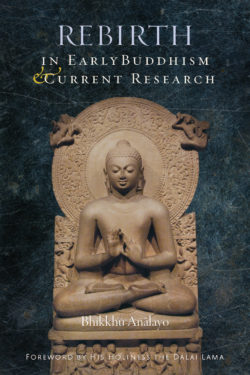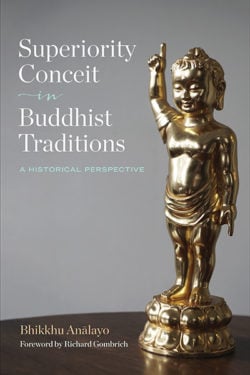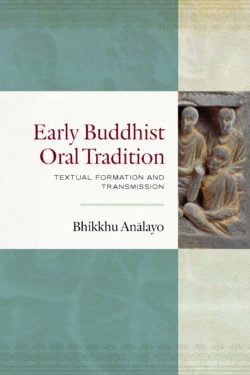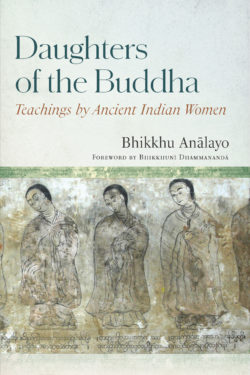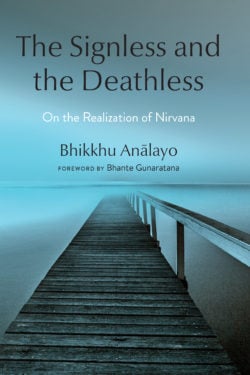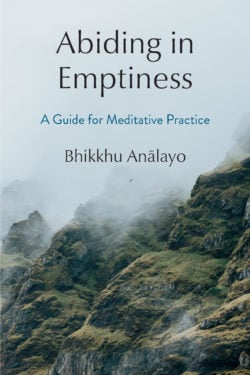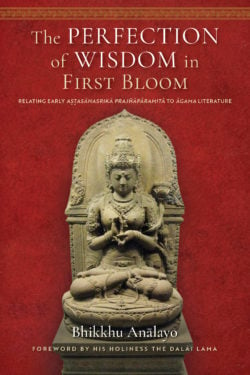Bhikkhu Anālayo
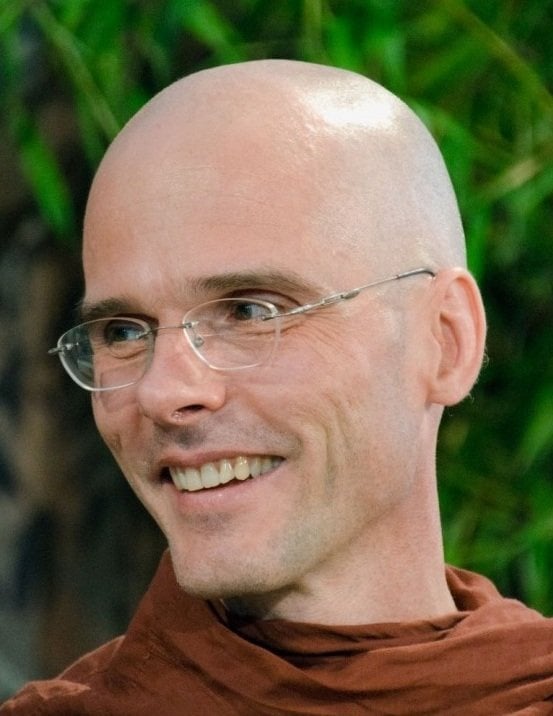
Bhikkhu Anālayo is a scholar of early Buddhism and a meditation teacher. He completed his PhD research on the Satipaṭṭhānasutta at the University of Peradeniya, Sri Lanka, in 2000 and his habilitation research with a comparative study of the Majjhimanikāya in light of its Chinese, Sanskrit, and Tibetan parallels at the University of Marburg, Germany, in 2007. His over five hundred publications are for the most part based on comparative studies, with a special interest in topics related to meditation and the role of women in Buddhism.
Books, Courses & Podcasts
Rebirth in Early Buddhism and Current Research
In four chapters, Rebirth in Early Buddhism and Current Research leads readers through:
-
the presentation of rebirth in the earliest Buddhist sources and the way it relates to core doctrine,
-
the debates about rebirth throughout Buddhist history and up to modern times, including the role of confirmation bias in the evaluation of evidence,
-
the current research on rebirth, including near-death experiences, past-life regression, and childhood recollection of previous lives,
-
and an examination of a particular case of xenoglossy, the ability to speak languages one has not been taught. As a very young boy, the Sri Lankan Dhammaruwan would chant Pāli-language scriptures that he had not apparently learned in his present life.
Rebirth in Early Buddhism and Current Research brings together the many strands of the debate on rebirth in one place, making it both comprehensive and compact. It is not a polemic but an interrogation of the evidence, inviting readers to draw their own conclusions.
The Child Who Chanted
The story of Dhammaruwan, a child who spontaneously began chanting suttas in Pali at two years old.
Dhammaruwan was born on the 18th of November 1968 in Matale, Sri Lanka. At an age of about 2 years he spontaneously would sit in meditation and then start chanting, as well as at times saying things in a language not understood by his mother, who tried to hush him up.
At a later time he and his mother went from Matale to Kandy to stay with Bertie and Rosa Seneviratne, who became his step-parents.
When Dhammaruwan was about three years old, his chanting of a part of the Dhammacakkappavattana-sutta was overheard by someone in the house, at a time when Bertie and Rosa had gone to India, leading to the eventual realization that he was chanting a Pāli text. On their return, Bertie encouraged the boy to continue and regularly made recordings of the chants, copies of which he would give to interested visitors. By the time of growing up into an adult, Dhammaruwan lost the ability to perform these chants.
According to Dhammaruwan’s memories, he learned the Pāli chants in a former lifetime in India, where he had been born as the son of a brahmin and trained in memorization of the Vedas. He had gone forth as a Buddhist monk and become a student of the eminent monk Buddhaghosa at Nālandā. After being trained as a reciter, together with other monks who had similarly been trained he was chosen to accompany Buddhaghosa from India to Sri Lanka. Having come to Sri Lanka, he stayed with Buddhaghosa at the Mahāvihāra in Anurādhapura.
Listen to Dhammaruwan’s chanting:
The Dhammacakkappavattana-sutta, the Buddha’s first sermon, in which he disclosed the four noble truths.
The Girimānanda-sutta, which lists ten meditative perceptions.
Superiority Conceit in Buddhist Traditions
Armed with his rigorous examination of the canonical records, respected scholar-monk Bhikkhu Anālayo explores—and sharply criticizes—four examples of what he terms “superiority conceit” in Buddhism:
- the androcentric tendency to prevent women from occupying leadership roles, be these as fully ordained monastics or as advanced bodhisattvas
- the Mahayana notion that those who don’t aspire to become bodhisattvas are inferior practitioners
- the Theravada belief that theirs is the most original expression of the Buddha’s teaching
- the Secular Buddhist claim to understand the teachings of the Buddha more accurately than traditionally practicing Buddhists
Ven. Anālayo challenges the scriptural basis for these conceits and points out that adhering to such notions of superiority is not, after all, conducive to practice. “It is by diminishing ego, letting go of arrogance, and abandoning conceit that one becomes a better Buddhist,” he reminds us, “no matter what tradition one may follow.”
Thoroughly researched, Superiority Conceit in Buddhist Traditions provides an accessible approach to these conceits as academic subjects. Readers will find it not only challenges their own intellectual understandings but also improves their personal practice.
Early Buddhist Oral Tradition
A fascinating investigation into the formation and transmission of the early Buddhist oral tradition.
For hundreds of years after his death, the Buddha’s teachings were transmitted orally, from person to person. In this volume, acclaimed scholar-monk Bhikkhu Anālayo examines the impact of such oral transmission on early Buddhist texts, be these monastic rules, verses, or prose portions of the early discourses. He scrutinizes various oral aspects of these texts, surveying evidence for memory errors, the impact of attempts at systematization, and instances of additions and innovations. Finally, he explores the implications of the nature of these texts as the final product of centuries of oral transmission and evaluates the type of conclusions that can—and cannot—be drawn based on them.
In-depth but still accessible, Early Buddhist Oral Tradition is an engrossing and enlightening inquiry into the early Buddhist oral tradition.
Daughters of the Buddha
A testimony to the invaluable contributions made by the women who were direct disciples of the Buddha—and a source of inspiration to Buddhist women today.
It’s a common perception that the earliest textual records don’t contain many, if any, teachings by the Buddha’s female disciples; yet, this is not the case. In fact, the earliest discourses record a range of teachings from Buddhist women, lay and monastic. Unfortunately their important contributions have so far not received the attention they deserve.
In Daughters of the Buddha, esteemed scholar-monk Bhikkhu Anālayo examines the accounts of the first female disciples in the canonical scripture, taking the reader back to the earliest period in the history of Buddhism that can still be accessed today. He dedicates each of the twenty-one chapters in the volume to an individual and remarkable woman, sharing her particular insights and teachings with the reader. Both nuns and laywomen are featured in these pages, and their diversity of voices and richness of thought will serve as instruction and encouragement for modern scholars and practitioners alike.
The Signless and the Deathless
An insightful examination of the end of suffering drawing much-needed attention to two overlooked factors of Nirvana: signlessness and deathlessness. Includes a foreword by Bhante Gunaratana.
Nirvana is at once a critical part of the Buddhist path and a concept difficult to fully understand for Buddhist practitioners. Canonical texts broach this mysterious and essential idea in a variety of ways, whether in the form of metaphor or literary description. In The Signless and the Deathless: On the Realization of Nirvana, scholar-monk Bhikkhu Anālayo sheds light on two key aspects of Nirvana that have gone underappreciated: signlessness and deathlessness.
Commanding an extraordinary mastery of canonical Buddhist languages, Venerable Anālayo breaks new ground, or rediscovers old ground, by presenting a new way of approaching Nirvana, based on the Buddha’s teachings on how our minds construct experience. This novel treatment, backed up by meticulous academic expertise, is valuable for scholars and practitioners alike.
Through practicing bare awareness…realizing Nirvana entails “a complete stepping out of the way the mind usually constructs experience.”
Abiding in Emptiness
Before the growth of the Mahāyānā and the Perfection of Wisdom, the Buddha gave his own teachings, to his attendant Ānanda, on the importance of emptiness (Pāli suññatā, Sanskrit śūnyatā) in formal meditation and everyday practice. In this volume, renowned scholar-monk Bhikkhu Anālayo explores these teachings and shows us how to integrate them into our lives.
Bhikkhu Anālayo draws from instructions found in the Greater and the Smaller Discourses on Emptiness (the Mahāsuññatasutta and the Cūḷasuññatasutta). In each chapter, he provides a translation of a pertinent excerpt from the discourses, follows this with clear and precise explanations of the text, and concludes by offering instructions for practice.
Step by step, beginning with daily life and concluding with Nirvana, Bhikkhu Anālayo unpacks the Buddha’s teachings on the foundational teaching of emptiness.
The Perfection of Wisdom in First Bloom
Coming soon! This book will be available in July 2025. Enter your name and email below to be notified when this book is available for purchase.
See the formative years of Mahayana Buddhist literature through the lens of the Perfection of Wisdom, expertly analyzed by the venerable scholar-monk Bhikkhu Analayo.
In this work we have a rare perspective on the early history of Mahayana Buddhism and the Perfection of Wisdom (Prajnaparamita), as far as this is still accessible in surviving texts. With his characteristic clarity and precision, Bhikkhu Analayo critically analyzes early Perfection of Wisdom literature based on the earliest extant versions of the Astasahasrika Prajnaparamita, or the Perfection of Wisdom in Eight Thousand Lines, one in Chinese and the other in Gandhari—one of the oldest surviving Mahayana manuscripts discovered to date. In reading this text from the viewpoint of early Buddhist literature, the author shows that what has generally been considered a sharp rupture in the formation of the Mahayana turns out to be more of a gradual evolution.
With his command of the languages of the ancient Buddhist world, scholar-monk Bhikkhu Analayo sifts through the layers of history and unveils new perspectives on the ideas and figures in early Perfection of Wisdom and Mahayana literature, covering such topics as the rhetoric of emptiness and the emerging bodhisattva ideal, as well as the status of women and the practice of self-immolation. In doing so, Bhikkhu Analayo reveals fresh insights into the gradual development that informs the emergence of early Perfection of Wisdom literature. This is a rare opportunity to peer through a window at the beginnings of Mahayana thought—before the traditions had coalesced into the familiar forms we see today.

